Research partnership sheds light on the knowledge exchange landscape in the forest sciences
By Kimberly Klenk, Dr. Vivian Nguyen, Dr. Alana Westwood, Dr. Matthew Falconer, Jenna Hutchen, and Tyreen Kapoor
From raging wildfires to destructive floods and habitat loss – these extreme events can be monitored and mitigated with targeted policies informed by the best-available science. Government departments like Natural Resources Canada (NRCan) are mandated to conduct science for the public good and ensure that the knowledge is shared. The process of sharing science is called knowledge exchange.
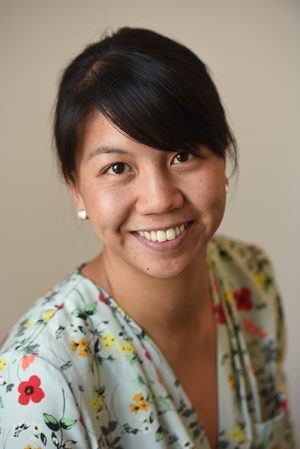
Vivian Nguyen, Assistant Professor, Institute of Environmental and Interdisciplinary Science, Carleton University
But how is it done effectively? And what even is ‘knowledge exchange’?
A team of researchers working between Carleton University, Dalhousie University and NRCan’s Canadian Forest Service (CFS) has been addressing these questions.
Led by Dr. Vivian Nguyen (Carleton University), Dr. Alana Westwood (Dalhousie University), and Dr. Matthew Falconer (NRCan-CFS), the project is funded by a SSHRC Partnership Engage grant. The partnership is one of the first focusing on science-policy solutions at NRCan and is a great example of collaboration and knowledge exchange itself across disciplines, including social science, linguistics, and forestry.
Using data from both a systematic literature review and a study of the CFS’s knowledge exchange model, we are understanding:
- how knowledge exchange is practiced,
- what effective approaches CFS staff use to share knowledge, and
- what best practices lead to successful knowledge exchange.
What we are learning is important for ensuring the forestry community is using up-to-date research and best-known practices for effective knowledge exchange.
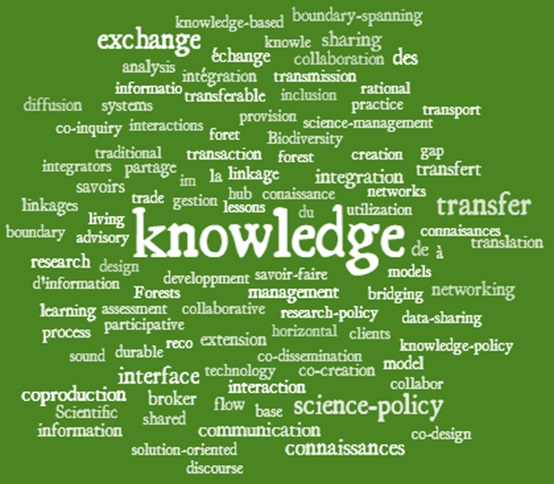
Image courtesy of Alana Westwood.
We need a shared language for common practice
We often hear ‘knowledge dissemination’, ‘science communication’, or ‘science transfer’ as terms describing ways to engage in knowledge exchange.
Through our systematic literature review of knowledge exchange studies in forest science, we identified no less than 90 unique knowledge exchange terms in English and 14 unique terms in French. Sharing a common scientific language, or in this case a common knowledge exchange language, makes it easier to collaborate and communicate effectively. It also makes it easier to study knowledge exchange and share learnings and practices.
Distribution of terms used in at least five items to represent or approximate ‘knowledge exchange’ by publication year of item.
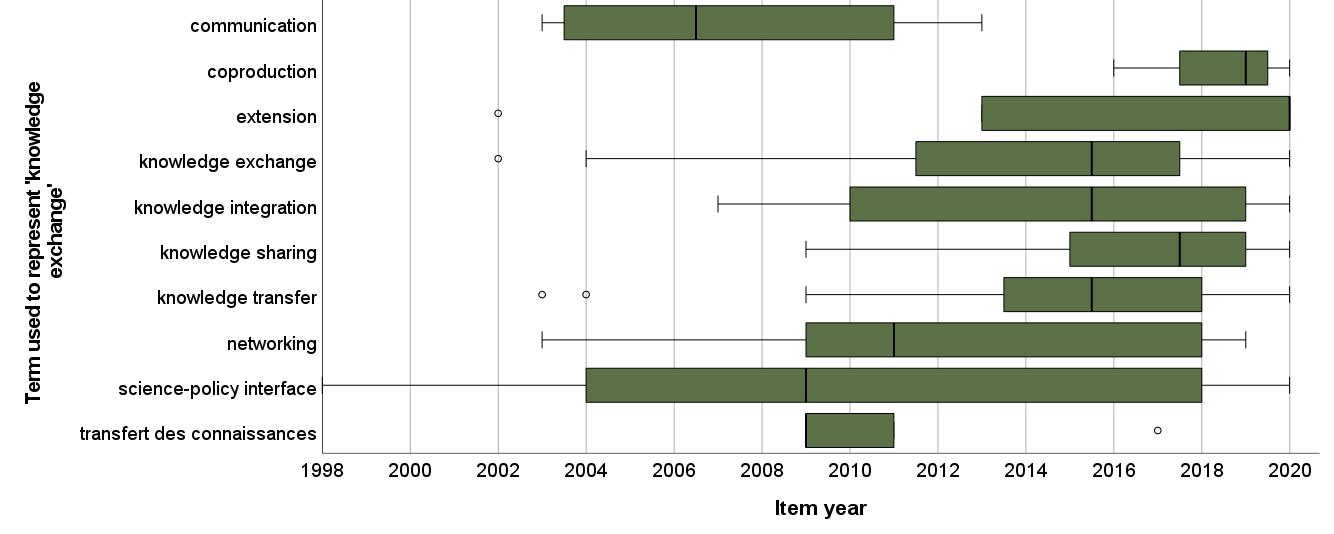
Westwood et al. In prep.
We recommend using the terms ‘knowledge exchange’ and ‘échange de connaissances’. These terms imply a multidirectional exchange of knowledge between knowledge producers and users. They also lend themselves well to participatory exchange models, where potential users of science are involved in producing that science.
Participatory exchange as well as network exchange, whereby knowledge is shared and exchanged through relationships and networks (e.g., by word of mouth), are often most effective according to other research and studies.
When we examined how people and organizations were practicing knowledge exchange, we identified the following types of exchanges:
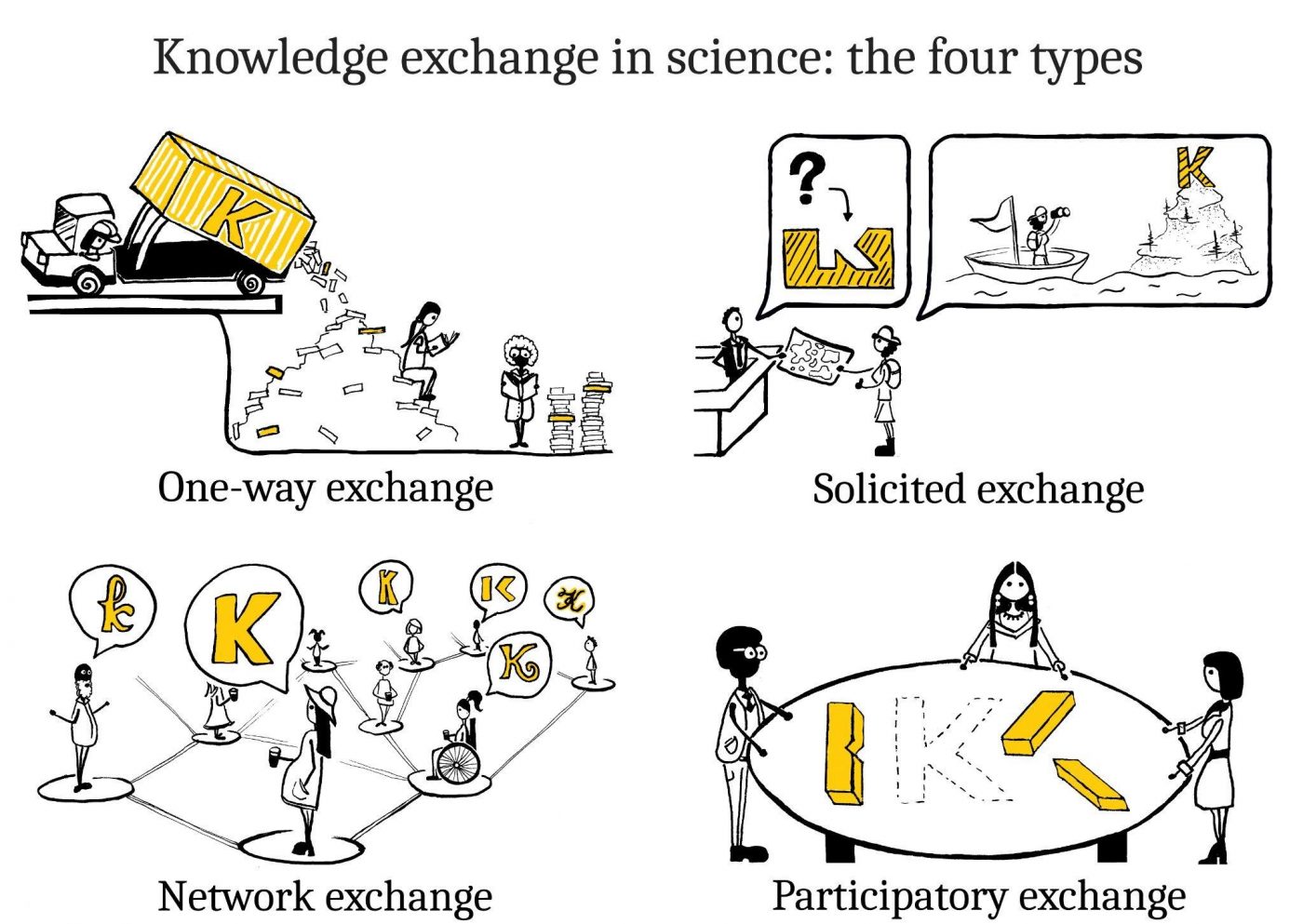
Comic by Sarah Perez, karatezeus21@gmail.com, @lunicatyo on Instagram.
Knowledge exchange in the Canadian Forest Service
Within NRCan’s CFS, knowledge exchange happens frequently both within and between the six research centres across the country. Such work is shaped by the local culture and the geographical distance between the centres. CFS recently created a national knowledge exchange framework (2018-29). The framework outlines CFS’s goal to promote and disseminate CFS science as widely and effectively as possible.
There is also an informal national working group called the Knowledge Exchange Group (KEG). This group brings together people involved in knowledge exchange to share notes and best practices. The KEG works to enhance multidirectional exchange within CFS and with forest sector stakeholders.
Best knowledge exchange practices
We were interested in examining CFS as a case study because of their unique model of embedding knowledge exchange specialists across the country. So, what we did was interview several knowledge exchange specialists to gain insights into knowledge exchange. From them, we learned about the lessons, best practices, and barriers encountered by scientists doing knowledge exchange in the forestry sector.
The knowledge exchange practitioners emphasized the importance of:
- relationship building,
- trust,
- mutual respect, and
- mutual learning with collaborators.
Building and maintaining relationships is done through numerous activities and types of communication, which involves a great deal of listening to the knowledge, needs, and concerns of stakeholders.
“I think maybe a key lesson is that, for me, you need to understand and learn what the end user needs,” says a knowledge exchange practitioner, “you have to listen, you have to make sure you work together.”
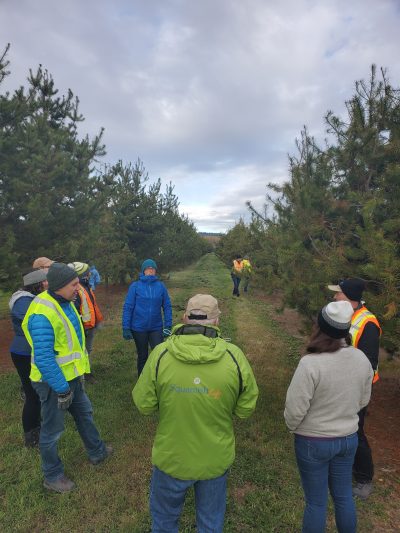
Exchanging knowledge and best practices through a seed orchard tour in British Columbia.
Knowledge exchange is most effective through collaborating with different audiences, such as policy makers, landowners, community members, and other scientists. “You need all levels of discussions to occur to create a vibrant knowledge exchange program,” says another participant, highlighting the value of establishing new relationships and incorporating different perspectives in projects.
Another key skill needed for successful knowledge exchange is to learn how to communicate science to the right audience, at the right time, and through the appropriate medium.
“Scientists who can speak in the language of their audience and are willing to do it all over and over again” is crucial to better enable knowledge exchange, according to one of our participants.
When doing research in a specific area, a knowledge exchange practitioner says scientists should “include different stakeholders. But include them at the beginning and include them in the process. Get their feedback. […] If it’s an Indigenous community you also need their permission as well.”
But a follow-through is just as important.
“Don’t get their opinions, do the project, and then let the project sit on the shelf, there has to be an implementation plan. That’s the whole idea behind having the stakeholders at the beginning.”
One reason why a project had been successful, according to one of our study participants, was that “it met issues that were identified by stakeholders and supplied them with potential answers. And gave them an opportunity to evaluate those answers that we were supplying.”
Given the distinct interests and experiences of forest stakeholders, their involvement in projects can contribute to ensuring the social and policy relevance of research and lead to better informed policies and practice. Our study of CFS knowledge exchange practitioners is showing us that building and maintaining relationships and trust with people at all levels is necessary to practice successful knowledge exchange.
EXPLORE CARLETON’S CERTIFICATE IN SCIENCE AND POLICY PROGRAM
For more information:
The knowledge exchange project and partnership between Carleton University, Dalhousie University, and CFS is ongoing.
An article on COVID-19 and the shift to digital knowledge exchange is forthcoming.
Systemic Mapping Protocol
CFS-GLFC e-lecture series
Project page on ResearchGate
Dr. Vivian Nguyen: https://viviannguyen18.wixsite.com/serac
Dr. Alana Westwood: https://westwoodlab.ca/